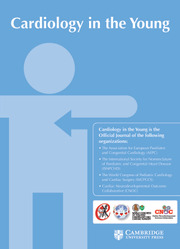No CrossRef data available.
Article contents
Paediatric scoring systems in congenital heart surgery: evaluating predictive accuracy for major adverse events
Published online by Cambridge University Press: 11 September 2025
Abstract
This study aimed to evaluate the predictive accuracy of Paediatric Risk of Mortality-III, Paediatric Index of Mortality-II, and Paediatric Logistic Organ Dysfunction scoring systems for major adverse events following congenital heart surgery.
This prospective observational study included patients under 18 years of age who were admitted to the ICU for at least 24 hours postoperatively following congenital heart surgery. Major adverse events were defined as a composite of 30-day mortality, ICU readmission, reintubation, acute neurologic events, requirement for extracorporeal membrane oxygenation, cardiac arrest requiring cardiopulmonary resuscitation, need for a permanent pacemaker, acute kidney injury, or unplanned reoperation.
A total of 116 patients, with a median age of 17.5 months (interquartile range: 5.4–60.0) were included in the study. Major adverse events occurred in 34 patients (29.3%). Paediatric Risk of Mortality-III (11.5 [8.0–18.8] vs. 7.0 [2.3–11.0]; p = 0.001), Paediatric Index of Mortality-II (3.8 [2.8–6.6] vs. 2.2 [1.7–2.8]; p < 0.001), and Paediatric Logistic Organ Dysfunction (12.0 [10.0–21.0] vs. 1.0 [1.0-10.0]; p < 0.001) scores were significantly higher in patients with major adverse events than in those without. The Paediatric Logistic Organ Dysfunction score (area under the curve 0.83; 95% confidence interval: 0.74–0.92) demonstrated the highest discrimination capacity compared to Paediatric Risk of Mortality-III (area under the curve 0.70; 95% confidence interval: 0.60–0.81) and Paediatric Index of Mortality-II (area under the curve 0.77; 95% confidence interval: 0.66–0.88) with good calibration (Hosmer–Lemeshow p > 0.05 for all). Based on the logistic regression model evaluation metrics, Paediatric Logistic Organ Dysfunction demonstrated better performance in predicting major adverse events compared with Paediatric Risk of Mortality-III and Paediatric Index of Mortality-II.
The Paediatric Logistic Organ Dysfunction score outperformed the Paediatric Index of Mortality-II and Paediatric Risk of Mortality-III scores in predicting major adverse events in paediatric patients admitted to the ICU after congenital heart surgery.
Information
- Type
- Original Article
- Information
- Copyright
- © The Author(s), 2025. Published by Cambridge University Press


